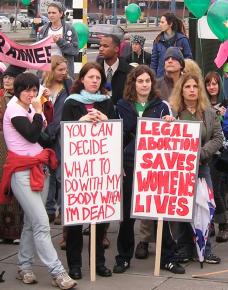A crisis in abortion funding
The right to an abortion is meaningless without the ability to afford one, writes , a member of the board of the Seattle-based Community Abortion Information and Resource Project.
WHILE Roe v. Wade ensures legal abortion in every state, the reality of abortion access today increasingly depends upon a woman's socioeconomic status and geographic location.
The average cost of an abortion for a woman up to 12 weeks pregnant is $450-600 in the Northwest region, and costs increase markedly after 12 weeks.
The Hyde Amendment, passed in 1976, ended the use of federal Medicaid funding for abortion, except when the woman's life would be endangered by a full-term pregnancy, or in cases of rape or incest. As the debate about the direction of health care reform takes off, the Obama administration should recognize the critical importance of repealing this fundamental barrier to women's access to comprehensive health care.
Fortunately, Washington uses its own funds to cover the cost of abortion procedures for women who qualify for Medicaid. However, women living in the neighboring states of Idaho and Oregon have limited government assistance for the cost of their procedures.
Oregon does cover abortion procedures through its Oregon Health Plan program; however, the program has seen significant budget cuts over the past year making it difficult for women to receive abortion funding in a timely manner.

Idaho does not use state funds to cover abortion, except in cases of life endangerment, rape or incest. Idaho even bans private insurance from covering abortion (except in cases of life endangerment) without payment of an additional premium.
Women in rural Washington, Oregon and much of Idaho also experience limited access to abortion providers. It is not possible to get an abortion past 14 weeks in Idaho, resulting in additional time and expense associated with travel.
AND THIS was before the economic crisis hit. With rising unemployment and cuts in social services added to the already challenging landscape of abortion access in the Pacific Northwest, increasing numbers of women experiencing an unintended pregnancy find themselves in an economic crisis of their own. For these women, private abortion funds help to fill the gaps left by inadequate state laws and funding by providing women with some or all of the funds needed to obtain an abortion.
The Community Abortion Information and Resource Project (CAIR) is an all-volunteer regional organization that provides abortion funding and hotline support to women in Washington, Alaska, Idaho and Oregon. The fund empowers women in need to be able to afford abortions and other associated costs, such as travel and child care. In 2007, the project gave $25,700 to women in need--leveraging the $171,500 the women were able to contribute to the cost of their procedures themselves.
As the gap between rich and poor in our country continues to widen, each year we find that the number of women who require our services increases. Much of this increased need is a result of a dramatic rise in the number of women calling us from Oregon--a state whose unemployment rate has soared above 12 percent. In 2005, only 27 percent of our clients were from Oregon; but in 2007, Oregon women made up 48 percent of the women we serve.
The drastic cuts to Oregon's Medicaid funding have led to virtually no new Medicaid enrollments and indefinite processing times for applications. As these women wait, the cost of their abortion and their financial stress rise.
As unemployment continues to increase while social services are being slashed in our region, we expect the need for our services will continue to increase.
Roe v. Wade's strength depends on our ability to make it meaningful for all women. While it is critical that we continue to engage in legal and political advocacy to improve state and national policies around abortion and reproductive health, we must also offer support to those who are in need of help now and can't wait.
First published in the Seattle Times


